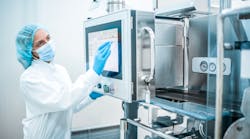Recent years have witnessed a sturdy boom in the development of biologics, especially monoclonal therapeutics in China’s biopharma sector. New facilities are proliferating throughout the country. While almost all Chinese biopharma companies have traditionally relied on stainless steel bioreactors for production, this new wave of biologics development goes hand in hand with single-use technology.
The Chinese bioprocessing industry has previously been characterized as conservative and cautious regarding adoption of new technologies, but this is changing. Plentiful investments are being made, while many of the facilities under expansion have plans to incorporate some of the most advanced technologies, including modern single-use technologies (SUT), and modular components. In 2016, Pfizer China kicked off its first biologics production facility in China, fully based on GE Healthcare’s single-use technology in a KUBio modular facility. JHL Biotech, the biologics CMO, founded by veterans from Genentech (Roche), also attributes the fast-track opening of its Wuhan base to the KUBio modular factory. Dozens of domestic biopharma companies are introducing single-use bioreactors or constructing single-use technology-based facilities as it provides a faster track for project development.
Two groups of companies are on the forefront of adopting single-use bioreactors: early stage mAb developers and biologics contract manufacturers. For mAb developers, single-use technology offers the key advantages of less capital investment during the project development stage, as well as time-reduction in facility construction. As most mAb developers in China are working on biosimilar/biobetter versions of mAbs against several established targets, with multiple companies vying for each target, the time to clinical development can mean life or death for a project. Though the regulatory authority in China used to be quite lenient with domestic generic makers, many analysts believe it may become stricter in the future with the ongoing health care reform. As a result, tardy players may be denied market access for their antibodies.
Biologics CMOs form another tribe of staunch supporters of single-use technology. The well-known biologic CMOs in China, including WuXi Biologics, JHL Biotech and MabPlex, all favor single-use bioreactors. As a CMO will serve multiple clients, cross-contamination becomes a high-priority and single-use technology eliminates the need for cleaning.
With both mAb development and outsourced biomanufacturing on the rise in China, there is no surprise that single-use technology is becoming more popular, enjoying double digit growth (some even project over 30 percent CAGR) in recent years.
There is a lack of unanimity concerning whether single-use technology can hang on to this momentum of growth in the next decade. First, there is a concern that this wave of mAb development may ebb in the next few years. This could dampen enthusiasm in this sector for investors as they find that the return of mAb therapeutics in China is more anemic than anticipated. Meanwhile, as more mAb projects are coming to clinical stage, their developers may prefer stainless steel bioreactors due to cost concerns when they are considering building their own commercial scale facilities. Though the Marketing Authorization Holder reform has opened the door for commercial scale outsourcing in China’s biopharma industry, domestic companies still have a strong tendency to keep manufacturing as their core competence. Many of the VC-backed developers seek IPOs, and Chinese investors are known to value fixed assets such as land and facilities over IP and product portfolios.
As Yogi Berra (may or may not have) said, it’s tough to make predictions, especially about the future. So, many developers are playing both sides, outsourcing pilot-scale production for now, but continuing to plan their own facilities when their projects go to late clinical stage. When Chinese developers build commercial scale facilities, they still see a high preference of stainless steel bioreactors over single-use. Rumbles from insiders suggest that the growth rate for stainless steel bioreactors is in the ascendant, while the market for single use technology will be pushed to the back burner in the next decade.



